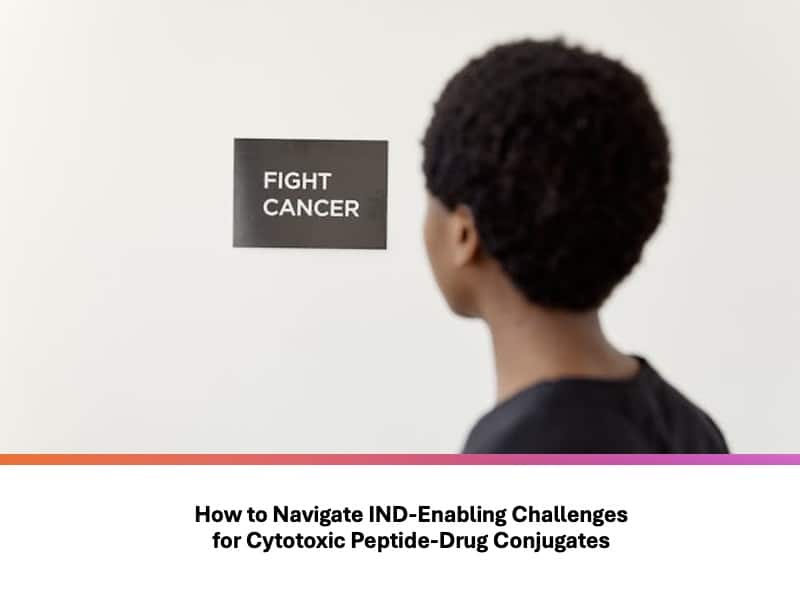How to Navigate IND-Enabling Challenges for Cytotoxic Peptide-Drug Conjugates
Cytotoxic peptide-drug conjugates (PDCs) hold enormous promise in oncology drug development, offering targeted delivery of potent therapies with minimized systemic toxicity.
Yet, moving these agents from discovery through Investigational New Drug (IND) submission presents a complex matrix of regulatory, pharmacological, and chemical hurdles.
For medicinal chemists and drug development teams, understanding how to anticipate and overcome these obstacles is essential.
This article examines the primary IND-enabling challenges for cytotoxic PDCs and provides guidance on navigating them successfully, drawing insights from real-world experience in accelerating peptide-drug conjugates through preclinical development.
Disclaimer: I’m not a medical doctor or pharmaceutical scientist. The information presented here reflects my interpretation of publicly available research, regulatory guidance, and industry best practices. It is intended for educational purposes only and should not be taken as professional medical or regulatory advice. Always consult qualified experts when making decisions related to drug development or clinical research.
What Are Cytotoxic Peptide-Drug Conjugates?
Advancements in cancer treatment represent some of the most important medical revolutions in history, transforming once-terminal diagnoses into manageable or even curable conditions.
Cytotoxic peptide-drug conjugates (PDCs) are an emerging class of targeted cancer therapies that combine the specificity of peptides with the potency of cytotoxic agents.
Designed to improve the therapeutic index of chemotherapy, PDCs aim to selectively deliver powerful payloads directly to tumor cells while minimizing damage to healthy tissues.
Each PDC typically consists of three essential components:
- Targeting Peptide: A short sequence of amino acids that binds to receptors overexpressed on cancer cells. These peptides are engineered for high specificity and low immunogenicity, allowing for precise targeting.
- Cleavable Linker: A chemically designed bridge that connects the peptide to the cytotoxic payload. The linker is engineered to remain stable in systemic circulation but cleave in response to tumor-specific conditions, such as acidic pH or specific enzymatic activity.
- Cytotoxic Payload: A highly potent drug, often 100 to 1,000 times more powerful than traditional chemotherapeutics. These agents—frequently DNA-damaging compounds or microtubule inhibitors—are lethal at extremely low concentrations and must be tightly controlled to avoid systemic toxicity.
What sets PDCs apart from other targeted therapies, such as antibody-drug conjugates (ADCs) or traditional chemotherapeutics, is their modular architecture and relatively small molecular size.
This enables enhanced tumor penetration and more rapid systemic clearance, potentially reducing off-target effects and improving therapeutic outcomes.
Recent advances in peptide engineering, linker chemistry, and site-specific conjugation techniques have expanded the clinical potential of PDCs.
However, their complex structure also introduces unique challenges in pharmacokinetics, toxicology, manufacturing, and regulatory strategy that must be addressed early in development.
What Is the Investigational New Drug (IND) Submission Process?
The Investigational New Drug (IND) submission process is a critical regulatory pathway that allows a new drug candidate, such as a cytotoxic peptide-drug conjugate, to be legally administered to humans in clinical trials.
Overseen by the U.S. Food and Drug Administration (FDA), the IND application provides evidence that a novel compound is reasonably safe for initial human exposure based on preclinical data.
An IND application generally includes three core components:
- Chemistry, Manufacturing, and Controls (CMC): Details the composition, synthesis, characterization, stability, and quality control of the drug substance and product. For PDCs, this includes in-depth data on the peptide, linker, cytotoxic payload, and conjugation methods.
- Pharmacology and Toxicology Studies: Summarizes the results of preclinical safety assessments, often conducted under Good Laboratory Practice (GLP) conditions. These studies evaluate potential off-target effects, genotoxicity, organ toxicity, and the therapeutic index in relevant animal models.
- Clinical Protocols and Investigator Information: Describes the proposed human trial design, including dosing rationale, study endpoints, inclusion/exclusion criteria, and informed consent procedures. The submission must also include credentials for clinical investigators and participating institutions.
The FDA typically reviews IND submissions within 30 days. If no clinical hold is issued, the sponsor may proceed with Phase I trials.
However, given the inherent toxicity of payloads in peptide-drug conjugates, the FDA may request additional data or clarifications before approving the trial to begin.
Sponsors are strongly encouraged to schedule a Pre-IND Meeting with the FDA to discuss development plans and clarify regulatory expectations.
This step is especially valuable for novel or high-risk compounds, as it can significantly de-risk the IND process and reduce delays.
In the case of cytotoxic PDCs, where the integration of biologics and small molecule elements adds considerable complexity, meticulous preparation and cross-functional collaboration are essential for a successful IND submission.
Unique IND-Enabling Complexities for Cytotoxic Peptide-Drug Conjugates
Unlike small molecules or monoclonal antibodies, peptide-drug conjugates combine multiple domains with distinct biological properties:
- A targeting peptide that selectively binds tumor-associated receptors
- A cleavable linker sensitive to the tumor microenvironment
- A cytotoxic payload that must remain inactive until it reaches the target site
Each component must demonstrate stability, bioavailability, and safety, both individually and as an integrated system.
Challenge #1: Payload Potency and Safety Profile
Cytotoxic payloads are, by definition, highly potent.
This potency raises red flags with regulatory agencies concerned about off-target toxicity.
Early safety pharmacology studies must carefully address:
- Tissue-specific toxicities related to premature payload release
- Genotoxicity concerns, especially with DNA-damaging agents
- Therapeutic window and systemic exposure levels
High-resolution in vitro assays and predictive toxicology models are essential to characterize safety risks before initiating animal studies.
Challenge #2: Linker and Conjugation Chemistry
The linker plays a pivotal role in controlling drug release kinetics. A poorly designed linker may either release the cytotoxin too early or fail to release it altogether, reducing efficacy or increasing toxicity.
Developers must establish:
- Chemical stability in plasma and circulation
- Predictable cleavage in the tumor microenvironment (e.g., acidic pH, enzymatic triggers)
- Scalable and reproducible conjugation methods
Robust analytical methods, such as LC-MS/MS and stability-indicating assays, are crucial for characterizing the consistency and integrity of conjugation.
Challenge #3: Bioanalytical and ADME Considerations
Pharmacokinetics for PDCs are notoriously complex.
Traditional ADME (Absorption, Distribution, Metabolism, and Excretion) strategies often fall short when applied to hybrid biologics.
Key considerations include:
- Measuring total vs. free payload concentrations in plasma
- Tracking intact conjugates vs. degraded components
- Evaluating tissue distribution and tumor uptake
Quantitative whole-body autoradiography and LC-MS-based bioanalytical methods can provide crucial insights into biodistribution and metabolism.
Challenge #4: Regulatory Expectations for IND Submission
The U.S. Food and Drug Administration (FDA) expects a well-structured IND package tailored to the specific risks and complexities of cytotoxic PDCs.
Some of the critical elements include:
- CMC Section: Detailed characterization of each component, batch reproducibility, and impurity profiling
- Pharmacology/Toxicology Section: Integrated safety data from multiple species, ideally using GLP-compliant studies
- Clinical Protocols: Justification of starting dose based on NOAEL, MABEL, or exposure matching
A pre-IND meeting can provide valuable guidance and de-risk the regulatory path. Developers should consult FDA guidance documents, such as M3(R2) and ICH S6(R1), for additional clarity.
Challenge #5: Manufacturing and Scalability
Manufacturing cytotoxic PDCs involves handling highly hazardous substances under strict containment procedures. CMOs must be equipped for:
- Safe synthesis and handling of toxic payloads
- Aseptic conjugation and purification processes
- GMP-compliant scale-up with validated cleaning protocols
Cross-functional collaboration between chemistry, toxicology, regulatory, and manufacturing teams is essential to align quality and safety expectations.
A Case Study in Streamlining Development of s Cytotoxic Peptide-Drug Conjugate
In one illustrative example, Syner-G BioPharma Group supported a biotech company in accelerating a cytotoxic peptide drug conjugate to IND a medicinal chemist journey to IND with Syner G Biopharma Group.
By implementing a staged development plan with parallel CMC and nonclinical workflows, the team reduced time-to-IND by over 30%.
Their approach to fast-tracking peptide-drug conjugates through preclinical development serves as a model of efficient coordination across scientific and regulatory domains.
Final Thoughts: Planning for Success
Fast-tracking cytotoxic PDCs to the clinic is achievable with rigorous planning, a deep understanding of linker-payload dynamics, and early alignment with regulatory expectations.
Medicinal chemists should take an integrated, cross-disciplinary approach, combining synthetic ingenuity, safety foresight, and regulatory literacy, to turn novel conjugates into viable clinical candidates.
For more detailed strategies and insights, refer to resources like the National Cancer Institute’s Cancer Drug Development Pathway and the FDA’s Drug Development Process.
Careful navigation of these IND-enabling challenges for cytotoxic PDCs can mean the difference between a stalled program and a successful clinical launch!
This website does not provide medical advice. This website site does contain affiliate links, and purchases may earn a commission.
Read my Medical Disclaimer, Review Disclaimer, and Publishing Policies for more details. Use of this site indicates acceptance of these terms.



